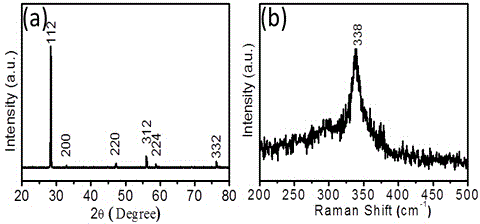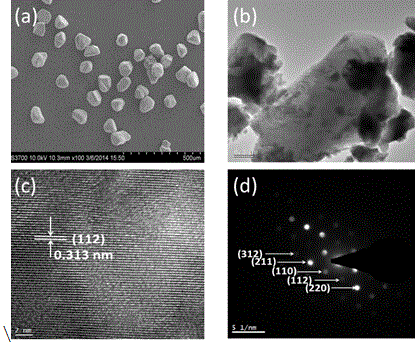Micron-sized spherical copper-zinc-tin-sulfur monocrystal particle preparation method
A technology of copper-zinc-tin-sulfur and single-crystal particles, which is applied in the manufacture of final products, sustainable manufacturing/processing, electrical components, etc., can solve the problems of difficult growth of large-size single crystals, large phase differences, and gaps, and achieve easy industrialization The effect of simple production and preparation equipment and low price
- Summary
- Abstract
- Description
- Claims
- Application Information
AI Technical Summary
Problems solved by technology
Method used
Image
Examples
Embodiment 1
[0045] (1) Preparation of Cu by hydrothermal method 2 ZnSnS 4 Nanoparticles: 2 mmol CuCl 2 2H 2 O, 1 mmol ZnCl 2 , 1 mmol SnCl 4 ·5H 2 O was dissolved in 30mL deionized water and stirred for 10min to obtain clear solution A; 5 mmol thiourea was dissolved in 20ml deionized water and stirred for 10min to obtain clear solution B; solution B was slowly added to solution A under stirring to obtain white The turbid solution was stirred for 10 min to obtain a mixed solution, and the mixed solution was transferred into a 100ml polytetrafluoroethylene autoclave and placed in the autoclave at 180°C for 16 hours, then cooled to room temperature and deionized water and absolute ethanol were used at 8000r / min. Centrifuge and dry at 60°C for 8 hours to obtain a black sample, that is, CZTS nanoparticles.
[0046] (2) Preparation of Cu by molten salt method 2 ZnSnS 4 Micron single-crystal particles: Weigh 18 mmol CuS, 12 mmol ZnS, 10 mmol SnS and 50 mmol CsCl as the flux, add 1 mmol o...
Embodiment 2
[0048] Weigh the reaction raw materials 18 mmol CuS, 12 mmol ZnS, 10 mmol Sn powder, 10 mmol S powder and 50 mmol CsCl as a flux, and add 1 mmol CZTS nanoparticles prepared in step (1) of Example 1 and mix them thoroughly to make them Mix evenly; put the mixed sample after grinding into a quartz bottle, and use the vacuum pump unit to vacuum through the three-way valve to reach 10-10 2 Pa (can also be protected with inert gas), so as to eliminate the influence of air on the molten salt reaction, seal the quartz bottle with an oxyhydrogen flame; place the sealed quartz bottle with mixed samples in an ordinary heating furnace to heat from normal temperature to 850 Keep the temperature at ℃ for 72 hours, then cool down to about 600℃, take out the quartz bottle and quickly cool it down to room temperature (put it in water); finally take out the sample in the quartz bottle, wash it with ultrasonic water several times to remove the flux CsCl, and then put the sample in a drying oven ...
Embodiment 3
[0050] Weigh the reaction raw materials 18 mmol Cu, 12 mmol Zn, 10 mmol Sn powder, 40 mmol S powder and flux 80 mmol CsCl, and add 2 mmol CZTS nanoparticles prepared in step (1) of Example 1 and mix them thoroughly to make them Mix evenly; put the mixed sample after grinding into a quartz bottle, and use the vacuum pump unit to vacuum through the three-way valve to reach 10-10 2 Pa (can also be protected with inert gas), so as to eliminate the influence of air on the molten salt reaction, seal the quartz bottle with an oxyhydrogen flame; place the sealed quartz bottle with mixed samples in an ordinary heating furnace to heat from normal temperature to 850 Keep the temperature at ℃ for 72 hours, then cool down to about 600℃, take out the quartz bottle and quickly cool it down to room temperature (put it in water); finally take out the sample in the quartz bottle, wash it with ultrasonic water several times to remove the flux CsCl, and then put the sample in a drying oven for 80 ...
PUM
| Property | Measurement | Unit |
|---|---|---|
| Mobility | aaaaa | aaaaa |
| Resistivity | aaaaa | aaaaa |
| Mobility | aaaaa | aaaaa |
Abstract
Description
Claims
Application Information
 Login to View More
Login to View More - R&D
- Intellectual Property
- Life Sciences
- Materials
- Tech Scout
- Unparalleled Data Quality
- Higher Quality Content
- 60% Fewer Hallucinations
Browse by: Latest US Patents, China's latest patents, Technical Efficacy Thesaurus, Application Domain, Technology Topic, Popular Technical Reports.
© 2025 PatSnap. All rights reserved.Legal|Privacy policy|Modern Slavery Act Transparency Statement|Sitemap|About US| Contact US: help@patsnap.com



